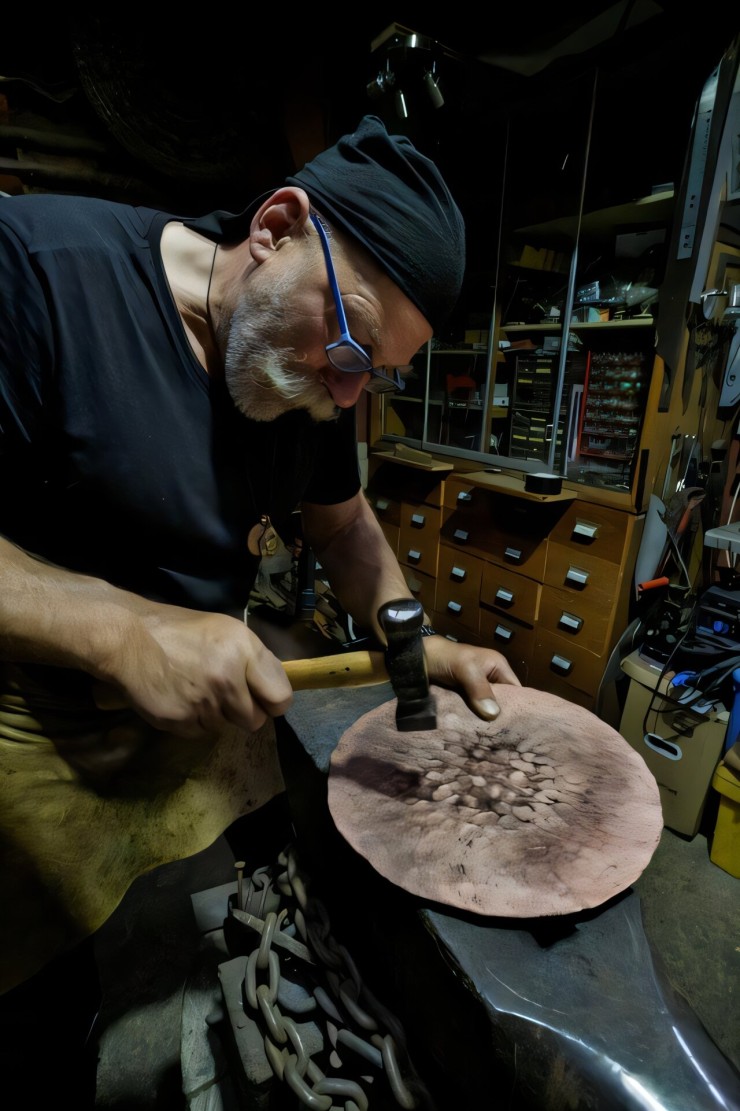Mistr Bauer, nutno podotknout, měl tak minimálně o 80% snadnější pokus, ocelové kladívko, kovadlina , určitě to i žíhal plynem....
Jo toto mně zajímá 👍díky za příspěvek pane GM 4 👌😉
Mystery of the Nebra Celestial Disk solved
Categories: Archaeology , Nebeský disk z Nebry




The article is included in categories:
- Archive of articles > Archaeology
- Archive of articles > Treasures > Pravěké poklady > Nebeský disk z Nebry
Post
Adhocu, ty zvíře :) Mě by zajímalo, zda by jsi to dal taky. A pokud ano, zda by to nemohlo viset u nás na prodejně? 
P.S: tvá/moje socha je trvalou ozdobou našich prostor :)
Ocel a kovadlina jsou jen placebo :D
Máro, tak já ti ho na prodejnu vybouchám a pěkně po staru i s vyfotodokumentací 👍 Teď ještě delám ,tu repliku toho slovanského meče ,jak sem sa vsadil s Namorem a tu ti dám taky, u vás bude viset i s Namorovim výučním listem 🤓👍 Akorát nemám tolik zlata, na ten disk, tož jestli by nevadilo, kdybych ty hvězdy a měsíce, vyšušnil z mosaze 🤓👍
Zlato dodám, mosaz nechcu :) Zkus spočítat kolik toho bude potřeba. Pecka!!! :)
Cémo tak to semw zvědavej jak se s tím popasuješ. Věřím že to bude pecka... 👍😀
Článek parádní 👍🙂 dokázali tenkrát neuvěřitelný věci...
Cože, Céma bude rozklepávat nejtek? 
Vedle hlavy kelta s Mšenských Žehrovic, která tady už je bude vypadat krásně 
To zlato, je tam patrně po krajích zatemované, to by mohl klidně doplnit Jákob ,šak se zlatem umí 👍 Udělám na tom přesně ty prohlubně a jen vyválcuje plíšky vystřihne a po okrajích zatepe 👍
Bude to taková kooperace ,doby bronzové 👌🤓 Už sa těším 😉👍
Pro zajímavost : datace disku z Nebry,byla dříve zpochybňována několika známými odborníky,kteří ho (mimo jiné i díky nejasným/pochybným nálezovým okolnostem) datovali až do doby železné.
Publikováním oněch pochyb a své vlastní interpretace datování nálezu v odborném tisku se následně rozpoutala menší vědecká třenice.
Viz např. : https://www.academia.edu/70640900/Critical_comments_on_the_find_complex_of_the_so_called_Nebra_Sky_Disk
Základní fakta o disku zde : https://is.muni.cz/el/1421/jaro2013/AEA_03/um/41000926/21_Disk_Nebra.pdf
Pane tvárnice, ten druhý odkaz je super 👍ale ty pédéefka na tom prvním, neumím otevřit na mobilu , tož jak je to s tou dobou ze železa 🤷♂️
Takže milý pane Adhoc,zde mám pro Vás novelizovaný seznam k Ježíšku : 1x kompjútr (https://cs.wikipedia.org/wiki/Ondra_(po%C4%8D%C3%ADta%C4%8D),lze programovat v jazyku Karel a 1x papuče.
https://sciencemag.cz/disk-z-nebry-je-pry-mladsi-a-tudiz-ne-tak-vyjimecny/
Ti vědci nakonec odešli s uřízlou šlí - mj. pro tu traseologii a dataci dřevěného materiálu z výkopu. Zajímavost také je, že to zlato bylo dodáváno do disku v průběhu několika staletí.
Já myslel, že záhadou je k čemu ten disk sloužil, né jak byl vyrobenej. Každopádně smekám před mistry dávných řemesel. 🤘🏻
Pane tvárnice,děkuju 👍🤓
Ať je to jak chce, tož stejnak je to hodně zajímavý předmět 👍
Tady je pr zajímavost odkaz do našeho slovníku pojmů - www.lovecpokladu.cz/slovnik-pojmu/nebesky-disk-z-nebry-167

Nebeský disk z Nebry | LovecPokladu.cz
Nebeský disk z Nebry
Tak tuhle diškusi jsem nějak minul a teď to tu čtu.
Adhoc - kuwa, bylo by to asi krásné, kdyby na nové základně nejznámějšího webu pro detektoráře visel meč slavného plagiátora a kumštýře Cementa obecného a u toho na tkaničce od bot můj výuční list 

Ale pozor, toto nebylo součástí sázky. To, že bude viset můj výúční list v průvaně, o tom není žádný písemný záznam! 


















